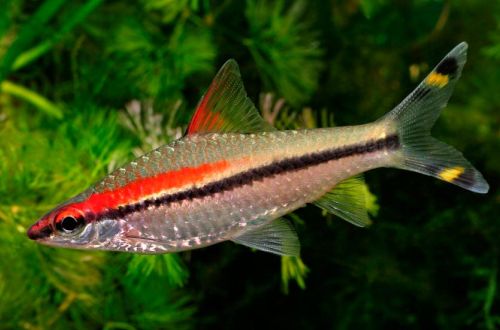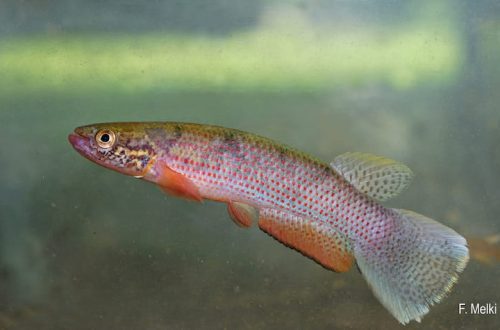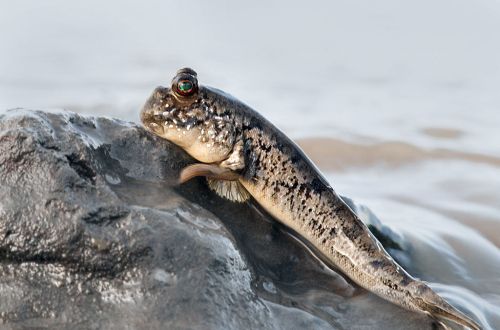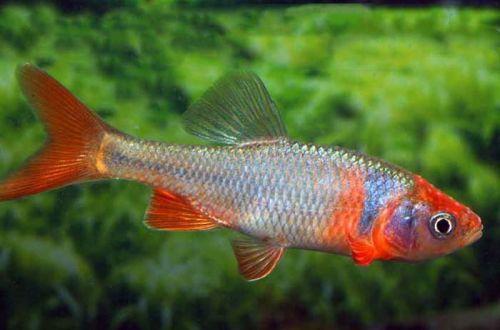
Barbus Denisoni
The Denisoni barb, scientific name Sahyadria denisonii, belongs to the family Cyprinidae (Cyprinidae). This fish received its scientific description in 1865 and is named after the governor of colonial India, William Thomas Denison (governor years 1861-1866). The second word “Sahyadria” is the local common name for the mountain ranges of the Western Ghats, where this species was found.

Contents
Habitat
Endemic from the southern part of India (the states of Kerala and Karnataka), on the territory of which the Western Ghats mountain range passes. It occurs in the upper reaches of rivers and reservoirs formed by them, originating high in the mountains. The natural habitat is characterized by a small lake or backwater with rocky shores and dense aquatic vegetation. The water is highly mineralized and differs significantly from the composition of lowland rivers.
Due to active fishing in nature, they are endangered, so India has introduced restrictions on the export of wild fish.
Brief information:
- The volume of the aquarium – from 200 liters.
- Temperature – 15-25°C
- Value pH — 6.5–7.8
- Water hardness – soft to hard (5-26 dGH)
- Substrate type — stony
- Lighting – subdued, moderate
- Brackish water – no
- Water movement – moderate
- The size of the fish is 9–11 cm.
- Food – any food of a suitable size, sinking
- Temperament – peaceful
- Keeping in a group of 6-10 individuals
Description
Adults reach a length of 11 cm. The fish has a slender, slightly elongated body. The coloration is silver. A black horizontal stripe stretches from head to tail, above which there is a characteristic bright red stroke in the front of the body. The dorsal fin is also painted in a reddish hue. The tail is translucent with two black and yellow markers. Sexual dimorphism is weakly expressed, it is problematic to distinguish males from females.
Food
Undemanding to the diet look. A balanced diet is one in which there are protein and vegetable components. It is recommended to use sinking feed. Foods rich in carotenoids such as astaxanthin are thought to increase red pigmentation. Their presence can be found on the packaging.
Maintenance and care, arrangement of the aquarium
The optimal size of the aquarium for a small flock of fish starts from 200 liters. Decoration is optional, provided that there are sufficient spaces for swimming. For example, about half of the tank can be left free of vegetation and other decorative elements.
When keeping Denison Barbs, the quality of water and its hydrochemical composition are of key importance. The fish need very clean water of high hardness, so regular cleaning of organic waste (food leftovers, excrement, etc.), monitoring of pH / dGH / oxidizability parameters and, most importantly, weekly water changes parts of water (30-50% of the volume) to fresh.
It is recommended to additionally include an aerator with several spray pebbles in the equipment set in order to increase the amount of dissolved oxygen. This is especially true if the aquarium has a lot of live plants. During the day, of course, they release oxygen, but at night, on the contrary, they absorb it.
Behavior and Compatibility
Peaceful active fish. Prefers to be in a group of at least 6–10 individuals; with a smaller number, it can become overly shy. Compatible with other non-aggressive species that can live in similar conditions.
Breeding / breeding
For commercial purposes, they are bred in large numbers on fish farms in Southeast Asia and Eastern Europe with the help of hormones. Cases of natural reproduction in home aquariums are quite rare, therefore, at the time of writing this article, there is no reliable information about the necessary conditions under which spawning occurs in Barbus Denisoni.
Fish diseases
In a balanced aquarium ecosystem with species-specific conditions, diseases rarely occur. Diseases are caused by environmental degradation, contact with sick fish, and injuries. If this could not be avoided, then more about the symptoms and methods of treatment in the section “Diseases of aquarium fish”.





